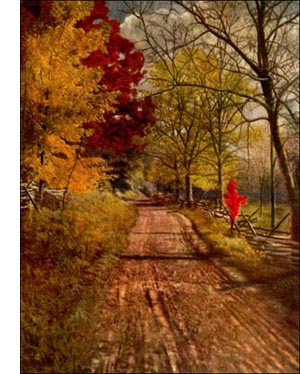California White Oak Tree
 California White Oak (Quercus lobata, Nee.)-A large, graceful tree with stout trunk dividing near the ground, with spreading top and pendulous branches, making a broad dome 80 to 100 feet high, and 150 to 200 feet in diameter. Bark brownish grey, scaly, with shallow furrows, and ridges broken into plates; twigs hoary, grey or reddish brown. Wood hard, fine grained, brittle and hard to season. Buds ovate, small, pubescent. Leaves alternate, variable, oblong or obovate, 2 to 4 inches long, deeply 7 to 11-lobed, thin, firm, pubescent, paler beneath; petioles short, broad, hairy. Flowers with half-grown leaves, February to April, staminate in hairy, yellowish catkins; pistillate, solitary and sessile, as a rule; stigmas broad. Acorns 1 1/4 to 2 1/4 inches long, annual, sessile (rarely stalked), solitary or in pairs, conical, elongated, with sharp, horny, hairy tip; cup shallow, tomentose, with thick scales that become finer toward fringed border; kernel, sweet, edible. Preferred habitat, rich, sandy loam. Distribution, valleys in California west of Sierra Nevada Mountains. Forms open groves, never forests. Uses: Splendid feature of natural scenery, but never successfully cultivated outside of its range. Wood useless except for fuel. Fruit used as food by Indians.
California White Oak (Quercus lobata, Nee.)-A large, graceful tree with stout trunk dividing near the ground, with spreading top and pendulous branches, making a broad dome 80 to 100 feet high, and 150 to 200 feet in diameter. Bark brownish grey, scaly, with shallow furrows, and ridges broken into plates; twigs hoary, grey or reddish brown. Wood hard, fine grained, brittle and hard to season. Buds ovate, small, pubescent. Leaves alternate, variable, oblong or obovate, 2 to 4 inches long, deeply 7 to 11-lobed, thin, firm, pubescent, paler beneath; petioles short, broad, hairy. Flowers with half-grown leaves, February to April, staminate in hairy, yellowish catkins; pistillate, solitary and sessile, as a rule; stigmas broad. Acorns 1 1/4 to 2 1/4 inches long, annual, sessile (rarely stalked), solitary or in pairs, conical, elongated, with sharp, horny, hairy tip; cup shallow, tomentose, with thick scales that become finer toward fringed border; kernel, sweet, edible. Preferred habitat, rich, sandy loam. Distribution, valleys in California west of Sierra Nevada Mountains. Forms open groves, never forests. Uses: Splendid feature of natural scenery, but never successfully cultivated outside of its range. Wood useless except for fuel. Fruit used as food by Indians.It is a happy circumstance for Californians and for all people who visit "the Land of the Setting Sun" that this valley oak is scorned by all lumbermen. The tree is practically worthless for timber, therefore gigantic individual trees stand scattered or grouped in the spacious valleys of western California, helping to make a landscape that cannot be duplicated this side of England. Indeed, Vancouver, journeying around the world in 1792, was astounded at the park-like Santa Clara Valley, set round with mountains, diversified with hills and intervales, covered with a carpet of verdure, and adorned with majestic oaks. Writing home of this landscape untouched by the hand of man, he says; " It required only to be adorned with the neat habitations of an industrious people to produce a scene not inferior to the most studied effect of taste in the disposal of grounds."
The California white oak is the largest and most graceful of the Western oaks., Its branches end in long shoots that are pendulous like those of the weeping willow. The trunk branches near the ground and rises and spreads out like a great fan. A British elm often has the same habit-our American elm, sometimes. The dome is broader even than that of our Eastern white oak. The twigs are willowy at first, but there is a surprising tortuousness acquired with added years. The limbs are gnarled in the most complex way. "Picturesqueness gone mad" well characterises the expression of the tree in its bare winter aspect.
"The Sir Joseph Hooker Oak," 100 feet high, 7 feet in diameter of trunk and 150 feet in spread of dome, on General Bidwell's farm in Butte County, California, was named after the great English botanist on the occasion of his visit with Asa Gray in 1877.
The tree is always broader than it is high, and bears a profusion of acorns of extraordinary length. These resemble the acorns of Quercus alba in other respects. The Digger Indians store them for winter use, and depend upon them as the source of their bread. They are roasted and hulled, then ground into a coarse meal, which is made into loaves and baked in rude ovens in the sand.
The leaves of Quercus lobata are of the true white oak type, with squarish lobes and pale linings. They vary in size and form, some being almost cut in two like those of the bur oak.
Attempts to introduce this tree into cultivation outside of its own range have proved unsuccessful. It is believed that the climate of Australia might be agreeable to the species, which is too exacting in its demands to thrive in Europe or in Eastern America.